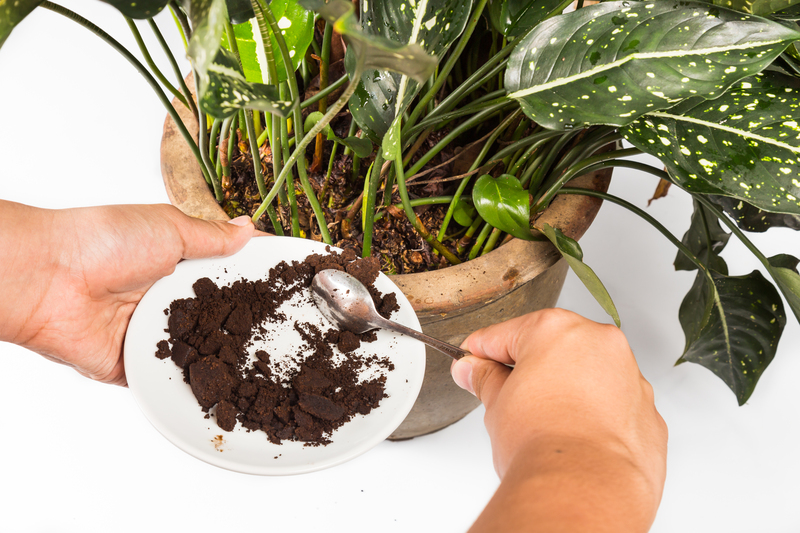Three Creative Ideas for Setting Up a Mobile Garden
Have you ever dreamed of having your own lush patch of greenery, but felt limited by space, sunlight, or a busy schedule? You're not alone! Whether you're living in an apartment, a rented home, or simply want the flexibility to shift your garden as the seasons change, a mobile garden offers a creative and eco-friendly solution. With a little ingenuity and some DIY spirit, you can cultivate a vibrant movable oasis that follows you wherever you go.
Let's discover three creative ideas for setting up a mobile garden and learn how these adaptable gardening methods can fit your lifestyle, boost your home's aesthetic appeal, and contribute to environmental sustainability.

Why Try a Mobile Garden?
Before diving into innovative mobile garden setups, let's explore why mobile gardening is gaining popularity among urban dwellers, renters, and gardening enthusiasts alike:
- Flexibility: Mobile gardens can be moved to chase the sunlight, escape harsh weather, or transform an indoor space into a verdant haven during winter.
- Space-saving: For those with limited outdoor space or balconies, moveable planters and green carts provide maximum utility.
- Temporary and Customizable: Renters or frequent movers can take their garden with them, ensuring continuity and reducing waste.
- Pest and Disease Control: Relocate vulnerable plants away from outbreaks, or bring them indoors for recovery.
- Accessibility: Mobile gardens can be designed at an ergonomic height for seniors or those with limited mobility.
With these benefits in mind, here are three original, creative methods to establish a portable garden that suits every lifestyle and decor.
1. Rolling Raised Bed Gardens: Urban Flexibility on Wheels
Why Choose a Rolling Raised Bed?
A rolling raised bed bridges the best of both worlds: the soil depth needed for healthy root development and the mobility to adapt to weather, sunlight angles, and social events. Perfect for patios, balconies, or paved backyards, these gardens-on-wheels can be repositioned with ease.
How to Build Your Own Rolling Raised Bed
- Materials: Select a sturdy, weather-resistant container (wood, composite, or recycled plastic), heavy-duty caster wheels (locking for stability), landscape fabric, quality soil, and your favorite plants.
-
Assembly Steps:
- Attach caster wheels securely to the base of your planter. Ensure the wheels can safely bear the weight when the bed is full.
- Line the interior with landscape fabric for drainage and weed control, then fill with high-grade soil mix tailored to your chosen plants.
- Plant a mix of vegetables, herbs, flowers, or dwarf fruit trees--anything your space and climate allow.
- Add a trellis on one side for climbing plants or vertical interest.
-
Mobile Gardening Tips:
- Rotate your raised bed regularly to ensure even sun exposure.
- In summer, move it into partial shade during heatwaves to protect sensitive plants.
- During storms, bring it under a sheltered area or indoors if possible.
The Benefits
- Large planting area compared to pots.
- Greater soil volume for healthy root systems.
- Effortless mobility thanks to sturdy wheels.
- Customizable size, finish, and configuration.
A rolling raised bed is a prime example of a creative, practical portable gardening solution for city living or anyone with changing needs.
2. Repurposed Cart Planters: Upcycled Charm for Your Mobile Oasis
Transform Old Carts into Mobile Garden Art
One of the most exciting mobile garden ideas is to turn an old utility cart, wagon, or wheelbarrow into a whimsical, eco-friendly movable garden. Not only does this approach offer practical mobility, but it also adds personality and character to your green space.
How to Repurpose a Cart into a Portable Garden
- Find Your Cart: Look for sturdy old serving trolleys, bar carts, laundry carts, or even an abandoned wagon at thrift stores or flea markets.
-
Prepare for Planting:
- Drill drainage holes in the cart's base if needed.
- Line the bottom with landscape fabric to prevent soil loss.
- Fill with a lightweight soil mix suitable for container gardens.
-
Add Your Plants:
- Choose shallow-rooted edibles (like leafy greens or strawberries), herbs, or compact flowers.
- For a dramatic look, mix cascading and upright plants, or coordinate colors for a themed display.
- Personalize: Paint or decorate the cart to match your patio or balcony style. Add hooks or small shelves for garden tools or watering cans.
Aesthetic and Ecological Advantages
- Recycling and reusing materials reduces waste and environmental impact.
- Easy to relocate your garden installation for entertaining or changing seasons.
- Makes a unique conversation piece and a striking addition to your mobile garden collection.
By repurposing carts, you'll not only embrace the principles of sustainability but also create a stylish, functional display that elevates your home's outdoor vibe.
3. DIY Modular Container Gardens: The Ultimate in Portable Gardening
What is a Modular Container Garden?
A modular container garden is a collection of individual planters--pots, crates, buckets--that can easily be grouped, stacked, or rearranged to create different effects. Using durable, lightweight containers with handles, wheels, or even custom-built trays, you can continuously redefine your outdoor living space.
How to Set Up a Modular Mobile Garden
- Choose Containers: Opt for planters with wheels or handles, stackable pots, or buckets with sturdy grips. Fabric grow bags are also a flexible, portable choice.
- Plan Groupings: Combine different heights, sizes, and colors for visual interest. Arrange containers according to sunlight requirements and ease of access.
- Mix Plant Types: Try themed gardens (for example, a "pizza garden" with tomatoes, basil, and oregano) or create a pollinator-friendly grouping with flowering plants.
- Water Management: Self-watering pots or trays make care and mobility even easier.
Advanced Modular Mobile Garden Ideas
- Vertical Modular Walls: Stack or hang pots on a movable trellis or wall frame with wheels to maximize growing potential in limited space.
- Rolling Plant Stands: Purchase or DIY a multi-level plant stand on casters for dramatic vertical displays.
- Seasonal Swaps: Change out containers according to the season, easily moving heat-sensitive or fragile plants indoors as temperatures shift.
The modular approach is ideal for experimental gardeners, those who frequently move, or anyone seeking ultimate creative control over their mobile garden's design and function.
Mobile Garden Maintenance Tips for Success
Creating a moveable garden is only the first step; keeping it thriving and beautiful takes a little ongoing care:
- Check mobility features: Regularly inspect wheels or handles for safety and ease of movement.
- Monitor moisture: Mobile garden containers may dry out faster than in-ground beds; use mulch, self-watering systems, or water-retaining gels as needed.
- Use quality soil: Lightweight, nutrient-rich soil mixes support healthy growth and make moving your garden less of a strain.
- Watch for pests: Being mobile lets you isolate or relocate affected plants quickly; consider natural pest repellents or physical barriers as needed.
- Rotate and adjust: Ensure all parts of your portable garden receive adequate sunlight by moving and reconfiguring containers as the seasons change.
With the right approach, your portable garden will flourish, bringing joy, color, and fresh produce or flowers wherever life takes you.
Choosing Plants for Your Mobile Garden
Recommended Plants for Mobile Gardening
- Herbs: Basil, mint, parsley, chives, and thyme thrive in containers and offer fresh flavors for your kitchen.
- Vegetables: Lettuce, radishes, cherry tomatoes, peppers, and spinach grow quickly and prolifically in small spaces.
- Flowers: Petunias, marigolds, pansies, begonias, and nasturtiums provide continuous color and interest.
- Dwarf fruit: Strawberries, blueberries, and even dwarf citrus or fig trees perform well in large containers with proper support.
- Succulents and Cacti: Perfect for low-maintenance portable gardens, especially in sunny, dry conditions.
What to Avoid
- Very large or deep-rooted plants: These may outgrow portable containers and become difficult to move over time.
- Heavy soil mixes: Use lightweight potting mixes to keep your garden mobile and easy to relocate.
- Plants with invasive roots: Some species can damage containers or crowd out neighbors in small spaces.

Conclusion: Reap the Rewards of a Creative Mobile Garden
Setting up a creative mobile garden is more than just a practical solution for transient lifestyles or urban spaces--it's a fulfilling hobby that offers flexibility, personal expression, and sustainable beauty. Whether you opt for a rolling raised bed, upcycled cart planter, or ingenious modular container setup, you'll enjoy the satisfaction of nurturing life anywhere, anytime.
So gather up your tools, let your imagination flourish, and start designing your own mobile garden today. Each moveable green oasis brings you closer to nature, no matter where life's journey takes you. Happy gardening!
Frequently Asked Questions About Setting Up a Mobile Garden
1. Can I use a mobile garden indoors?
Absolutely! Many portable garden ideas work beautifully indoors. Just ensure your chosen plants have access to adequate sunlight or supplement with grow lights, and safeguard surfaces from moisture.
2. How often should I move my mobile garden?
There's no strict rule--move your garden as needed for sunlight, weather protection, convenience, or decoration. Regular adjustments keep your plants healthy and help prevent pest issues.
3. What's the best way to make sure my mobile garden is stable?
Use locking wheels or ensure carts and planters have a wide, stable base. Don't overload the top, and place heavier items on lower shelves or directly above the wheels.
4. Can I grow larger vegetables in my portable garden?
You can, but choose compact or dwarf varieties for best results. Use deeper containers for root crops and ensure each plant has adequate space to thrive.
5. How do I prevent spills or mess when moving my mobile garden?
Avoid overfilling containers with water, and use saucers or trays to catch runoff. Move gardens slowly and support tall plants to prevent toppling.
Ready to take the next step in mobile gardening? Start with one of these innovative mobile garden ideas and transform any location into your personal green retreat!